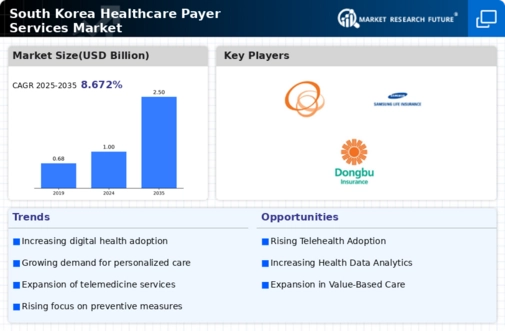The South Korea Healthcare Payer Services Market is characterized by a complex and competitive landscape, influenced by various stakeholders including private insurance companies, government regulations, and consumer demands. As the healthcare system evolves, payer services are increasingly focusing on innovative solutions, quality improvement, and customer engagement. The landscape is shaped by rising healthcare costs, a growing aging population, and advances in medical technology, pushing companies to differentiate their offerings. Competition is not only driven by pricing but also by the ability to provide personalized services tailored to individual patient needs.
The strategic collaborations, innovative technologies, and overall customer service strategies employed by these organizations play a crucial role in determining market share and sustaining competitive advantages within this diverse sector.MetLife Korea has established itself as a prominent player in the South Korea Healthcare Payer Services Market, leveraging its global expertise to deliver localized healthcare solutions tailored to the needs of Korean consumers. The company offers a wide range of health insurance products, enabling consumers to choose plans that best fit their individual lifestyle and health requirements.
MetLife Korea is known for its strong brand recognition and financial stability, which foster trust among policyholders. With a significant focus on digital transformation, MetLife Korea has enhanced customer engagement through easy-to-use digital platforms, providing a seamless experience for policy management and claims processing. These strengths allow MetLife Korea to maintain a competitive edge in the market, effectively responding to shifts in consumer demands and market trends.Lina Korea operates within the South Korea Healthcare Payer Services Market as a key player, specializing in health insurance products designed to cater to both individual and corporate clients.
The company's product offerings include comprehensive health plans, critical illness coverage, and supplemental health insurance options, aimed at promoting preventative care and minimizing out-of-pocket healthcare expenses for clients. Lina Korea's market presence is bolstered by its commitment to customer-centric services, aligning with the evolving expectations of the Korean population. The organization has strengthened its position through strategic partnerships and collaborations that enhance service delivery and expand its portfolio. Additionally, Lina Korea's focus on innovative technology and data-driven solutions enables efficient operations and effective risk management, allowing the company to respond agilely to market dynamics.
Through continuous improvement and attention to customer needs, Lina Korea aims to reinforce its standing within the competitive landscape of South Korea's healthcare payer services.




